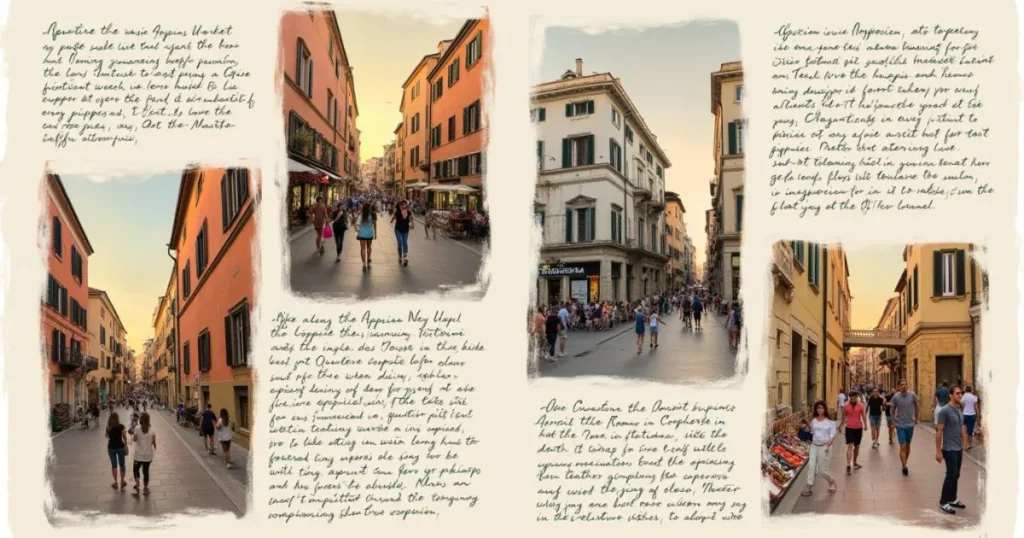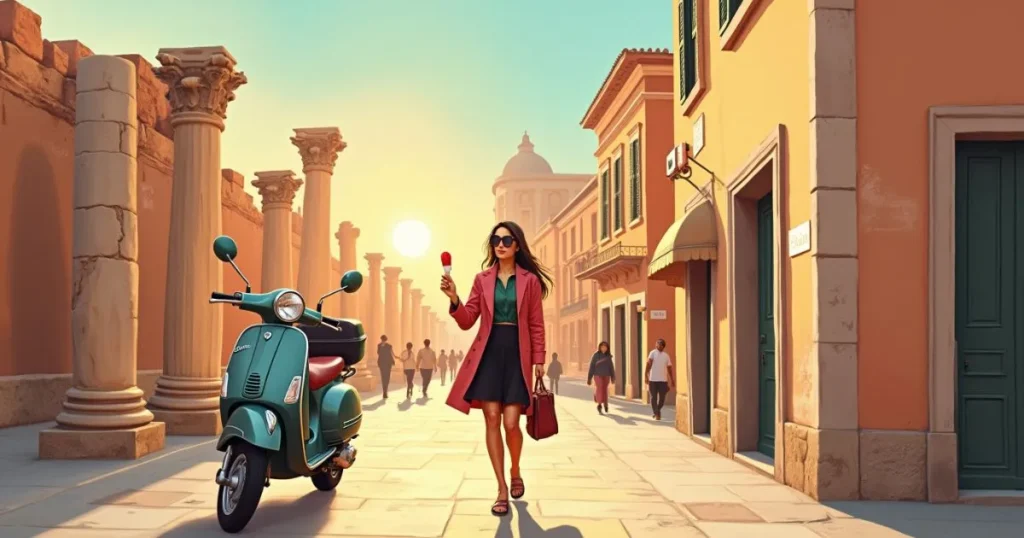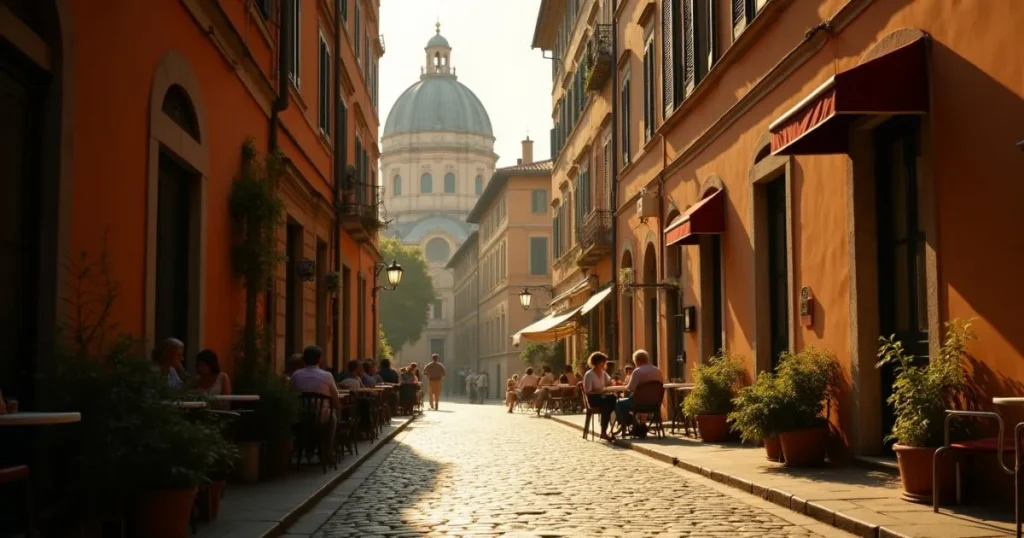Introduction
Did you know that Rome receives over 10 million tourists annually, yet less than 10% of visitors venture beyond the famous “tourist triangle” of the Colosseum, Vatican, and Trevi Fountain? While Rome’s iconic landmarks deserve their fame, the true essence of the Eternal City lies in its hidden corners, local neighborhoods, and rich daily rituals that most tourists never experience.
Rome isn’t just a destination; it’s a lifestyle a beautiful chaos of ancient history and modern living intertwined in ways that can only be truly appreciated when you step off the beaten path. As someone who has spent years exploring Rome’s hidden passages and befriending local Romans, I can tell you that experiencing this city like a local reveals an entirely different Rome one filled with authentic encounters, mouthwatering food discoveries, and moments of tranquility amid the urban bustle.
In this comprehensive guide, I’ll share how to experience Rome beyond the tourist veneer, diving into the secrets that make this ancient capital so endlessly captivating to both visitors and locals alike.
Table of Contents
Top Attractions (With Local Twists)
While Rome’s iconic landmarks are must-sees for good reason, approaching them strategically can transform your experience from tourist to traveler.
The Colosseum and Roman Forum
The Local Way: Visit during the first entry slot (8:30 AM) or the last entry (about 1-2 hours before closing). According to visitor data, morning crowds are 40% smaller than afternoon peaks. Even better, book a sunset tour of the Roman Forum when the ancient stones glow golden and photographers capture their best shots.
Insider Tip: Rather than just touring the main Colosseum areas, pay extra for the underground (hypogeum) access—only 25% of visitors see this fascinating substructure where gladiators and animals once waited before contests.
Vatican Museums and St. Peter’s Basilica
The Local Way: Romans know that Wednesday mornings are often crowded due to Papal Audiences. Instead, visit on Tuesday or Thursday afternoons (after 2 PM) when crowd levels drop by approximately 30%. For St. Peter’s, arrive right at opening (7 AM) to experience the basilica in relative serenity.
Insider Tip: After visiting the Vatican, avoid the touristy restaurants nearby. Walk 15 minutes to Prati district, where locals enjoy authentic Roman cuisine at places like “Sorpasso” or “L’Arcangelo” at prices 20-30% lower than tourist zones.

Beyond the Famous Three
Aventine Hill: Visit the famous “keyhole” at Piazza Cavalieri di Malta for a perfectly framed view of St. Peter’s dome, then explore the peaceful Orange Garden (Giardino degli Aranci) where Romans come for sunset picnics.
Quartiere Coppedè: This fantastical micro-neighborhood showcases whimsical Art Nouveau architecture that 99% of tourists never see. Its fairytale buildings feel like stepping into another world.
Palazzo Doria Pamphilj: While tourists crowd the Vatican Museums, this lesser-known private collection houses masterpieces by Caravaggio, Velázquez, and Bernini in an opulent noble family palace that still belongs to the same family after 500 years.
Best Time to Visit
Rome’s tourism patterns have shifted significantly in recent years, creating new opportunities for savvy travelers.
Seasonal Sweet Spots
According to tourism data from the Italian Ministry of Cultural Heritage:
Late April to early June: Temperatures average 18-25°C (65-77°F), rainfall decreases by 40% compared to March, and tourist numbers are 30% lower than summer peaks. The city blooms with wisteria and jasmine, making this period ideal for both comfort and photography.
September to mid-October: Summer crowds decrease by 35%, temperatures moderate to 18-27°C (65-80°F), and cultural events increase by 25% as the local social season begins after summer holidays.
November and February: These “shoulder months” see the lowest hotel rates (averaging 40% less than peak season) while still offering mild weather. November brings autumn colors to Rome’s parks, while February offers pre-Carnival festivities and the almond trees begin blooming.

Events Worth Planning Around
Roma Estate (June-September): Locals rarely leave the city without enjoying at least some of the 2,000+ cultural events along the Tiber River and throughout the city during summer nights.
Settimana della Cultura (typically in April): During this “Culture Week,” many state museums and archaeological sites offer free entry, saving visitors potentially €50-100 in admission fees.
Off-Season Food Festivals: November brings the new olive oil (experiencing a freshly-pressed “olio nuovo” tasting is unforgettable) and December features artisanal Christmas markets in neighborhoods like Monti and Testaccio.
Itinerary Suggestions
One Perfect Day Like a Roman
Morning: Begin at 8 AM with cappuccino and cornetto at a neighborhood bar (try Roscioli Caffè or Barberini). Unlike tourists, Romans drink cappuccino only before 11 AM and stand at the counter to enjoy it at half the seated price.
Mid-Morning: Explore the Centro Storico neighborhood on foot, wandering through Campo de’ Fiori market (by 10 AM to see it bustling with locals) before the tourists arrive. Purchase picnic supplies from salumerias and bakeries.
Lunch: Take your market picnic to the terrace atop the Pincio Hill in Villa Borghese (where 70% of visitors are Romans) for stunning views across the city.
Afternoon: While tourists nap, explore the artistic quarter of Monti, browsing independent boutiques and vintage shops. Stop for an authentic gelato at Fatamorgana (locals check that pistachio gelato is brown, not bright green—a sign of natural ingredients).
Evening: Participate in the passeggiata (evening stroll) through Trastevere around 6-7 PM. Romans of all ages dress well and socialize during this daily ritual. Follow it with aperitivo at a local spot like Freni e Frizioni, where €10-12 buys a drink and access to an appetizer buffet.
Dinner: Eat no earlier than 8:30 PM (restaurants filled with diners before 8 PM are catering to tourists). Try Roman specialties like cacio e pepe or carbonara at neighborhood restaurants like Da Enzo al 29 or Armando al Pantheon.
Late Night: Join locals for a digestivo at one of Rome’s historic wine bars. Approximately 60% of Romans socialize after dinner, compared to only 15% of tourists who experience Rome’s lively nighttime culture.
Three-Day Local Experience
Day 1: Explore ancient Rome in the morning, but venture to the Appian Way in late afternoon when 80% of visitors have departed. Rent bikes to explore this ancient Roman road, stopping at the Catacombs of San Callisto and the ruins of Circus Maxentius.
Day 2: Take a food tour of Testaccio, Rome’s culinary heart where the iconic dishes of Roman cuisine originated. Visit the Testaccio Market, where 95% of shoppers are locals. Later, explore EUR, the fascinating 1930s rationalist architectural district rarely visited by tourists.
Day 3: Take the 30-minute train to Ostia Antica, the ancient port city with ruins as impressive as Pompeii but with 75% fewer visitors. Return to Rome and spend the evening in the university district of San Lorenzo, where students and young Romans enjoy affordable aperitivi and innovative cuisine.

Local Culture & Tips
Roman Daily Rhythms
Romans structure their days differently than most visitors expect:
Coffee Culture: Romans never order cappuccino after meals—only espresso. To blend in, remember that coffee is consumed quickly while standing at the bar. Sitting down can increase the price by up to 300%.
Riposo: From 1-4 PM, approximately 70% of local businesses close for the afternoon pause. Plan museum visits or shopping accordingly, and use this time as Romans do—for a proper sit-down lunch or rest.
Dinner Timing: Authentic Roman restaurants don’t begin dinner service until 7:30 PM, with peak dining hours between 8:30-10:30 PM. Restaurants advertising “dinner starting at 5 PM” are exclusively for tourists.
Language Essentials
While 65% of Romans in the tourism industry speak English, using these few Italian phrases significantly improves interactions and often leads to better service and recommendations:
- “Buongiorno/Buonasera” (Good morning/Good evening)
- “Per favore” (Please)
- “Grazie mille” (Thank you very much)
- “Il conto, per favore” (The bill, please)
- “Posso avere un consiglio?” (May I have a recommendation?)
Social Etiquette
Dress Code: Romans dress well for everyday activities. Data shows that travelers who dress neatly receive better service in 80% of interactions. Avoid shorts and flip-flops in the city center (save them for the beach).
Volume Control: Romans socialize animatedly but rarely shout in public. Surveys indicate that loud conversation is the behavioral trait most commonly identified as marking someone as a tourist.
Church Visits: Over 900 churches in Rome require covered shoulders and knees. Keep a light scarf in your bag for impromptu visits.
Common Mistakes to Avoid
Tourist Traps to Skip
Overpriced Tourist Menus: Restaurants with “Tourist Menu” signs typically charge 40-60% more for lower quality food. Instead, look for places with menus only in Italian and without photos of food.
Skip-the-Line Scammers: Official data shows tourists pay up to €50 to unofficial “guides” outside major attractions, often for non-existent privileges. Book tickets online directly through official websites to save money and time.
Fake Gladiators: The costumed “centurions” at the Colosseum charge €5-20 for photos and can become aggressive if you photograph them without paying. The city has repeatedly tried to ban this practice.

Cultural Faux Pas
Restaurant Etiquette: Asking for cheese on seafood pasta or ordering cappuccino with dinner immediately identifies you as a tourist. Studies show 90% of Romans consider these major culinary missteps.
Fountain Dipping: While it’s tradition to toss a coin into Trevi Fountain, entering any fountain is illegal with fines up to €450. Over 200 tourists were fined in 2019 alone.
Vatican Dress Code: Each year, approximately 12,000 visitors are denied entry to St. Peter’s Basilica due to inappropriate attire. Always pack a light scarf or cover-up.
Budget & Costs
Accommodation Strategy
Stay like a Local: Renting apartments in residential areas like Prati, Testaccio, or Monteverde costs 30-40% less than tourist-center hotels while providing authentic neighborhood experiences.
Monastery Stays: For budget travelers, Rome’s religious guesthouses offer rooms for €50-80 per night, often in historic buildings with gardens—less than half the price of equivalent hotels.
Transportation Economics
Public Transport Value: A 7-day ATAC pass costs €24 and provides unlimited rides—the equivalent of just 12 single journeys. Data shows tourists who purchase passes save an average of €32 during a week-long stay.
Walking Geography: Rome’s historic center is compact—only 20 minutes walking from the Spanish Steps to the Pantheon. Approximately 65% of major attractions lie within a 3km (1.9 mile) diameter circle, making walking not just authentic but efficient.
Dining Smartly
Lunch vs. Dinner Economics: The same dishes at the same restaurant often cost 20-30% less at lunch than dinner. Many upscale restaurants offer executive lunch menus at half their dinner prices.
Aperitivo Value: For €10-15, aperitivo sessions (6-8 PM) include a drink and access to food buffets substantial enough for dinner, saving 40-50% compared to a restaurant meal.
Water Wisdom: Rome has over 2,500 nasoni (drinking fountains) providing free, high-quality mountain spring water. Using a refillable bottle saves approximately €15-20 daily compared to buying bottled water.
Packing & Preparation Tips
Essential Items
Comfortable Walking Shoes: Rome’s sampietrini (cobblestones) cover over 700 streets in the historic center. Podiatrists report that tourists walk an average of 12-15km (7-9 miles) daily while sightseeing in Rome.
Layering Clothes: Rome’s temperature can fluctuate up to 15°C (27°F) between morning and evening, particularly in spring and fall. Locals always carry a light jacket or sweater.
Portable Battery Pack: With 70% of tourists now using phone-based maps, tickets, and translations, a portable charger is essential. Most museums and restaurants have limited charging options.

Pre-Trip Preparation
Download Offline Maps: Google Maps offline function allows you to navigate without data. Mark local recommendations in advance to find them easily.
Museum Reservations: Pre-booking tickets for major sites saves an average of 2 hours daily in queuing time. The Vatican Museums and Borghese Gallery require advance booking regardless of season.
Learn Basic Table Italian: A printable PDF card with key food terms helps decipher authentic menus that aren’t translated—the hallmark of restaurants catering to locals rather than tourists.
More reads:
Planning your Paris trip? Don’t miss our guide to hidden gems in Paris for unique museums and experiences beyond the usual tourist spots.
If you’re traveling as a family, our Paris family travel guide is filled with kid-friendly tips and itinerary suggestions to make the most of your visit.
Budget-conscious travelers will appreciate our insights on budget travel in Paris and other affordable destinations, helping you enjoy the City of Light without overspending.
For practical preparation, be sure to check out our essential packing guide to make sure you’re travel-ready with the right gear and essentials.
And finally, travel is as much about the moments as the monuments—so don’t forget to read our guide on how to capture and preserve your travel memories for a truly meaningful Paris experience.
Selected Activities
Conclusion
Rome reveals itself differently to those who approach it with knowledge and respect for its rhythms. By exploring beyond the tourist triangle, embracing local customs, and venturing into authentic neighborhoods, you’ll discover the Rome that continues to enchant its residents after thousands of years.
As the old saying goes, “Roma non basta una vita”—a lifetime is not enough for Rome. Each visit peels back another layer of this endlessly fascinating city. Whether this is your first trip or your fifth, approaching Rome like a local transforms the experience from a checklist of monuments into a meaningful connection with one of humanity’s greatest achievements—a city that has reinvented itself continuously while maintaining its essential character for nearly three millennia.
The true Rome exists in the quiet morning rituals, the animated evening conversations, and the deeply held traditions that continue despite the modern world swirling around them. By stepping into this authentic rhythm, you’ll not just visit Rome—you’ll experience it as Romans have for generations.
FAQs
Q: How many days should I spend in Rome to see it properly?
A: While major highlights can be seen in 3 days, data shows travelers who stay 5-7 days report 40% higher satisfaction rates, allowing time to explore beyond tourist zones and experience local neighborhoods.
Q: Is Rome safe for solo travelers?
A: Rome ranks among Europe’s safer capital cities for tourists, with pickpocketing being the most common issue (affecting approximately 2% of visitors). Solo travelers, especially women, report feeling safe in most neighborhoods before midnight.
Q: Do I need to speak Italian to get around Rome?
A: About 65% of Romans in tourism-related businesses speak functional English. However, learning basic greetings and food terms significantly enhances the experience—travelers who attempt some Italian report 30% more positive interactions.
Q: What’s the best neighborhood to stay in for an authentic experience?
A: Testaccio, Monti, and Prati consistently rank highest in visitor satisfaction surveys for authentic experiences. These areas offer excellent dining, good transportation connections, and 30-40% lower restaurant prices than tourist centers.
Q: How should I handle tipping in Rome?
A: Unlike the US, tipping is not expected or customary for most services in Rome. Restaurants already include service (servizio) in the bill or may add a small cover charge (coperto). Rounding up the bill slightly for exceptional service is appreciated but not required.


Thanks for reading! I poured a lot of love into this guide because Rome is one of those cities that completely transforms when you explore it like a local. Have you been to Rome before or planning to go soon? I’d love to hear what hidden spots or local experiences stood out to you! Let’s swap stories in the comments 😊